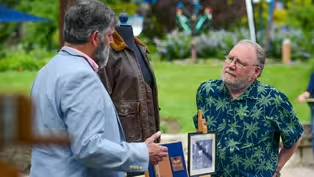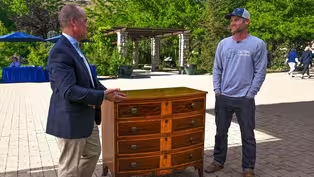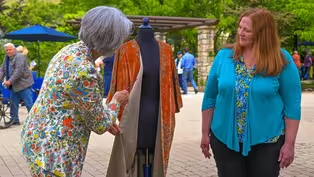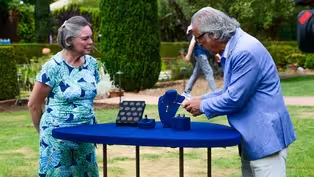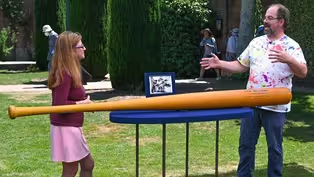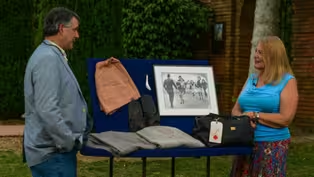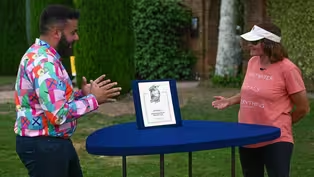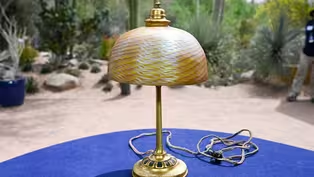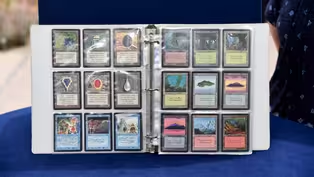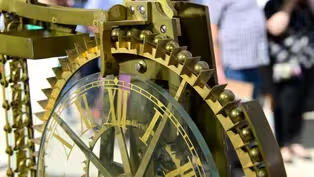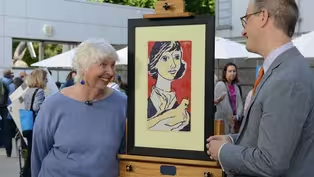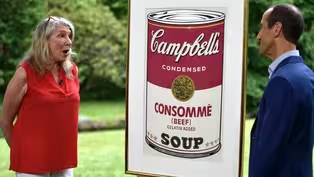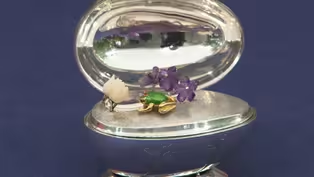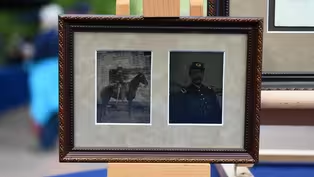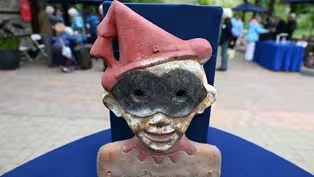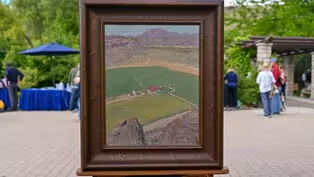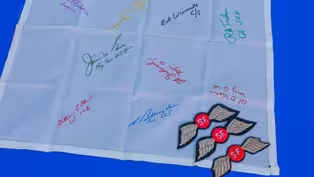
RECUT: Idaho Botanical Garden, Part 1
Special | 22m 31sVideo has Closed Captions
Gem State treasures sparkle in this half-hour RECUT at Idaho Botanical Garden!
Gem State treasures sparkle in this half-hour RECUT at Idaho Botanical Garden, including a wooden toy general store, ca. 2000, WWII Special Force wings, and a Maynard Dixon oil painting, ca. 1913. Which is $50,000 to $80,000?
Problems playing video? | Closed Captioning Feedback
Problems playing video? | Closed Captioning Feedback
Funding for ANTIQUES ROADSHOW is provided by Ancestry and American Cruise Lines. Additional funding is provided by public television viewers.

RECUT: Idaho Botanical Garden, Part 1
Special | 22m 31sVideo has Closed Captions
Gem State treasures sparkle in this half-hour RECUT at Idaho Botanical Garden, including a wooden toy general store, ca. 2000, WWII Special Force wings, and a Maynard Dixon oil painting, ca. 1913. Which is $50,000 to $80,000?
Problems playing video? | Closed Captioning Feedback
How to Watch Antiques Roadshow
Antiques Roadshow is available to stream on pbs.org and the free PBS App, available on iPhone, Apple TV, Android TV, Android smartphones, Amazon Fire TV, Amazon Fire Tablet, Roku, Samsung Smart TV, and Vizio.
Buy Now
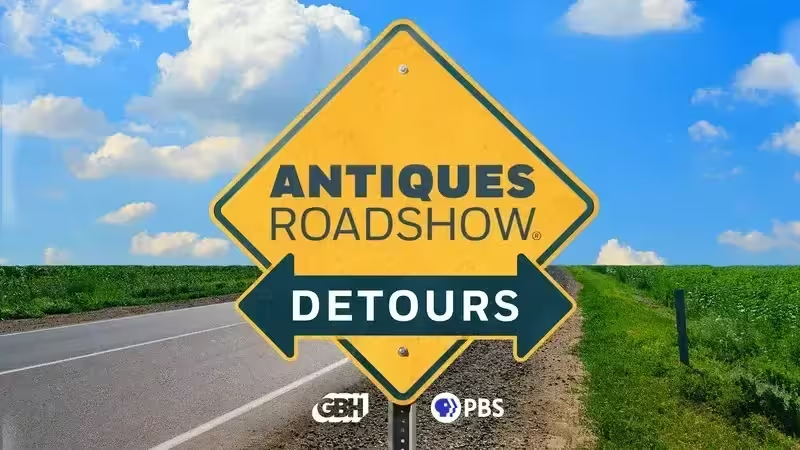
ANTIQUES ROADSHOW DETOURS
Ever wondered what happens to the treasures featured on America’s beloved ANTIQUES ROADSHOW after the cameras leave town? Host Adam Monahan tracks down the juicy afterlives of your favorite finds from PBS’s hit series.Providing Support for PBS.org
Learn Moreabout PBS online sponsorshipMore from This Collection
America’s favorite treasure hunt ANTIQUES ROADSHOW presents a bite-sized way to enjoy the show. ANTIQUES ROADSHOW RECUT features thirty-minute episodes, packed full of favorite finds and paced for maximum entertainment. RECUT features episodes recut from the show’s previous visits to distinctive and historic locations across the country.
RECUT: Idaho Botanical Garden, Part 4
Video has Closed Captions
Wrap up Season 4 of RECUT with a $50,000 appraisal at Idaho Botanical Garden! (22m 31s)
RECUT: Idaho Botanical Garden, Part 3
Video has Closed Captions
Visit the “City of Trees” for unbe-leaf-able Boise treasures in this half-hour RECUT. (22m 31s)
RECUT: Idaho Botanical Garden, Part 2
Video has Closed Captions
In this half-hour RECUT, watch breathtaking Boise appraisals at Idaho Botanical Garden. (22m 31s)
Video has Closed Captions
Watch wow-worthy Woodside finds in this half-hour RECUT and learn which is up to $44,000! (22m 24s)
Video has Closed Captions
In this half-hour RECUT episode, golden state treasures shine at Filoli. One is $150,000! (22m 23s)
Video has Closed Captions
Watch fascinating Filoli finds in this half-hour RECUT, including one up to $100,000! (22m 36s)
Video has Closed Captions
This season's first half-hour of RECUT wows our guests with a $200,000 to $330,000 find! (22m 30s)
RECUT: Desert Botanical Garden, Part 2
Video has Closed Captions
Phoenix treasures heat up, like one appraisal up to $35,000, in this half-hour RECUT! (22m 28s)
RECUT: Desert Botanical Garden, Part 1
Video has Closed Captions
Phenomenal Phoenix finds abound in this half-hour RECUT. One is worth up to $100,000! (22m 26s)
RECUT: Crocker Art Museum, Part 2
Video has Closed Captions
See stunning Sacramento finds like one $80,000-$125,000 treasure, in this half-hour RECUT! (22m 28s)
RECUT: Crocker Art Museum, Part 1
Video has Closed Captions
Head to California’s Crocker Art Museum for a bite-sized RECUT! One find is up to $75,000! (22m 27s)
RECUT: Winterthur Museum, Garden & Library, Part 2
Video has Closed Captions
Discover Delaware treasures in this half-hour RECUT, including one valued at $50,000! (22m 27s)
Providing Support for PBS.org
Learn Moreabout PBS online sponsorship♪ ♪ CORAL PEÑA: "Antiques Roadshow Recut" is unearthing some fantastic finds at the Idaho Botanical Garden in Boise.
GUEST: I didn't even know if it was real or not, I just thought it was cute as heck.
Goodness!
(chuckling) That, that's a surprise.
♪ ♪ PEÑA: A jewel within the city limits of Boise, the Idaho Botanical Garden was established in 1984 and grew from an interest in reimagining part of the grounds of the Old Idaho Penitentiary, a prison that operated for 101 years and closed after riots in 1973.
Today, the garden promotes horticulture in the Treasure Valley using native and domestic plants.
Now let's uncover what treasures our cameras captured amongst the beautiful flora.
I think it was probably about ten years ago, when I went to a garage sale, while my husband was going through the barn, pulling out things that he was interested in, and asking how much, and the young man said, "Well, just make a pile."
This fella was just propped up on the porch, kind of up against a stair.
And because of my age, I know that he's a shooting gallery target.
So I said, "Well, would this be for sale?"
He said, "Yeah, just add it to the pile."
We said, uh, "Okay, what do we owe you?"
He said, "How about $100?"
You see that it's dated 1911.
And you see the name on it in Los Angeles, California.
So Dickman was born in Wisconsin in 1876.
Okay.
And then as a young man, he finds himself in Los Angeles, and comes upon these shooting gallery, they called them rigs.
I used to go to Coney Island as a kid, and actually played with one of these things.
And a rig was cast iron.
Some of them were mobile, and they moved around... Oh, right.
...for fairs and country fairs.
Yeah, I remember, yeah.
And others were stationary, and they were all operated by chains, a metal chain.
Mm-hmm.
So there was noise; they would clatter.
And then the sound of the bullets hitting the metal targets.
And it was a racket.
It was just so much fun.
So Dickman buys a rig in Los Angeles, and within two or three years, he has three rigs.
And these rigs need constant repair.
They need replacement parts.
And all of the makers of the shooting gallery rigs were east of the Mississippi.
So he's out in Los Angeles, on the West Coast, alone, and there is the story of the entrepreneur.
He decides to go into business.
And this was patented in 1911.
And this was his most famous target, so... Oh, okay!
His rigs had hundreds of targets.
This one would have been the principal target.
And his system was called the bright eye system.
One of these eyes was lit with a gas flame.
I didn't know that!
When you shot the bullet through the eye, you extinguished the gas flame.
But immediately, the other eye would light up.
(laughs) So it was going back and forth.
Boom, boom, boom, boom.
It would light, go out, light, go out.
How cool is that?
I, I had no idea.
Yeah, and you can see the wear where all the little bullet dings... Oh, that's why it's textured.
And this is a result of thousands of bullets.
Most of the paint on it is original.
It's a beautiful natural patina.
So Dickman made rigs up and down the West Coast.
He went out of business in 1934.
Other manufacturers started to copy this clown, except they're not signed Dickman.
And eventually, especially when we went off to war, the Depression comes along, a lot of the rigs were taken apart and melted down as scrap metal.
Because it's patented in 1911, we know it was made shortly after that.
So this was probably made in the teens, early '20s.
These targets are very highly desirable.
Oh, good.
Uh, there's a book on shooting gallery targets.
This is on the cover of the book.
Oh, wow.
It's considered, really, the, the pinnacle of shooting gallery technology, as well as, the imagery is like a piece of Pop Art.
Retail, we're going to place a value of $20,000 to $22,000.... Oh, wow.
...on this clown.
(chuckles): And you're not joking.
And I'm not clowning around with you.
You're not clowning around.
(both laugh) Uh, so we bought this typewriter at an estate sale for $30.
Uh, it's a Remington Rand, and it says Model 1, which we heard is kind of old.
So excited to see what it's worth today.
But we looked online, and it said maybe around $1,850 if it's the oldest one, so fingers crossed... Yeah.
...that it's, it really is the oldest one.
GUEST: Well, the only thing that I know is, they're cloisonné.
This one was, um, filled with rose petals for years and years, and we emptied it out to see if there was any little treasure in the bottom.
Was there?
And there were just rose petals.
Back then, in 1915 to '25, which is when these were made, these were very exotic items.
So they would have been very proud of having this set.
It's an egg.
It's an egg.
Do we know anything more about the egg?
I purchased it, and I think I got two more with it.
I spoke to my son, and he said he got two of 'em, so there was three of 'em.
Oh, okay.
Where did you acquire these?
Off an online auction.
Probably nine years ago?
Okay.
Ten years ago?
It's been a while.
Wow.
And do you recall what you paid for the egg?
(sighs) Not much.
A couple of hundred bucks, a hundred buck, yeah.
Okay, for the set of three.
Yeah.
Did they give you any information about these particular eggs that you were buying?
No, no.
So it was sort of a...
They were just cute.
I collect cute things.
(laughing): Okay.
Well, I, I think that this is adorable.
Yeah.
So kudos to you.
Thank you.
This is a wonderful novelty piece.
Okay.
Uh, we've got a beautiful footed egg with a gorgeous foliate concentric design that's rolling around the edges.
Okay.
It's got a beautiful seamless hinge that runs along the entire width of the piece.
Okay.
The signature is Cartier.
Your item is clearly defined as item number eight out of a series of 25.
Okay.
It's made out of sterling silver with 18-karat yellow gold accents.
Oh, cool.
It was made in 1977.
We've got the Cartier emblem on the very front.
It opens, and we've got a delightful scene with a little enameled frog.
On the bottom of his foot, he is marked Cartier.
And we know that this is authentic.
So it's real.
Really?
Yes.
See, that's what, I always wanted to know that!
Yes!
And then you've got the beautiful, charming flowers with the amethyst that would have been carved in Idar-Oberstein, Germany.
And then you also have carved coral flowers, which would have been done in Italy.
Wow.
So this is a global piece, with all the elements coming together into one delightful package.
Oh, my gosh!
So an Easter egg, limited-edition series, by a wonderful well-known maker in Cartier.
Yeah!
Would you have any idea as to the value of this piece in today's market?
I didn't even know if it was real or not.
I just thought it was cute as heck, so I have no idea.
(both laughing) Well, I think that your investment in the three, despite the fact that you have just one with you today... Yeah.
I might have two more when I get home, depending on how much it is.
(laughing) I'm going to call him-- it's my son.
(laughing) Say, "Son, give me those back."
Yeah!
If you were to see an item like this come to auction, you could reasonably anticipate an auction estimate of $1,000 to $2,000 just for the one egg.
Awesome.
So with having three... Yeah!
Fun!
...you could be doing quite well.
And again, that's a tremendous... Yeah!
...uptick in value over what you originally paid for it.
Yeah, and now I know it's real.
♪ ♪ PEÑA: A number of plants and trees in the Lewis and Clark Native Plant Garden were used by Indigenous peoples for medicinal purposes.
The Shoshone used the blue flax plant as a hair and body wash and to treat eye and gastrointestinal problems.
The Nez Perce made an infusion from the bark of the western larch for treating colds and chewed the sap to soothe a sore throat.
I brought in a picture of an execution in Warrenton, Virginia.
My mother had it in a, in a box of things, and I got it out and had it framed for her, and then, when she died, I acquired it.
Who is the person you think is responsible for this drawing?
Okay.
My great-great-grandfather.
My mother wrote all that stuff down in the lineage on the back of the pictures.
This drawing depicts a brigade in the Army of the Potomac fighting for the Union cause during the course of the Civil War.
You provided us with the name of your ancestor, complete with a middle initial.
And I did a little research on the men that were in this brigade.
I checked all of their regimental rosters, trying to find a name that lined up.
I only found one, and he was a private in the 96th Pennsylvania.
More than likely, he is the drawer, the artist involved in making this drawing.
And from the drawing, it is clear to me he was a witness to the event.
However, the two tintypes you have are of an infantry officer, of a lieutenant, and I could find no one with that name that served in this brigade who was an officer.
So I'm relatively confident the images are not of... Of him.
...the gentleman you believe it is.
But I am firmly confident that the drawing was done by a, a witness to the event who was in that brigade, and more than likely is your ancestor, whose name you provided.
So maybe those items got mixed up at some point in time.
Mixed up somewhere.
Or the story about who it is got mixed up.
There are a lot of pictures that have been drawn of Civil War camp scenes by the soldiers who were there, and sometimes aftermaths of battles, but you just rarely see an execution of a deserter.
This is a mid-war execution, the summer of 1863.
Executions for desertion were not quite as common as we're sometimes led to believe.
And President Lincoln commuted a lot of those.
I would assume that this gentleman did something particularly egregious that they felt the need to have a battlefield execution.
He's sitting there on his casket... Yep.
...the one he's about to spend eternity in.
We've got the firing squad drawn up.
We've got the whole brigade around him to witness this.
And the layout of the camp, it's got little notations-- "ambulance corps," "battery."
The subject matter is rarely, if ever, depicted.
Amazingly, this drawing is in very, very nice condition.
You can clearly see the fold lines from where it was folded up and mailed home in a small envelope.
It's been very well preserved, and apparently always been cared for.
Camp scenes drawn by participants do sell from time to time.
They're not horribly common.
But a typical example is $500, $1,000, maybe $2,000, if it's particularly artistic.
This is a great example of content trumps everything.
You just don't see a period witness drawing of an execution.
Execution.
This drawing alone-- even if the I.D.
isn't quite correct, the drawing is absolutely complete, correct, authentic-- it would probably sell in the $5,000 to $7,000 range... Wow.
...at auction.
And you've certainly got several hundred dollars worth of tintypes there.
If he's not identified, those tintypes are going to bring $400 to $600 at auction for the pair.
Mm-hmm.
Maybe a little more.
If we can really tie them all together and tie the I.D.
all together, the entire grouping could hit the $8,000-plus range.
Wow, okay, that's cool.
It's going to continue hanging on my wall, but... (laughing) Well, that's wonderful.
I would hope it would stay in the family.
This is a table that we bought in a garage sale about 15 years ago.
MAN: And what did you have to pay for it?
About 15 bucks.
No, I mean, we like it either way, but we just want to determine whether it's something that we need to keep precious or we just use it every day.
Well, it, I got it at a garage sale, when we were all going to garage sales, 'cause it was the Warm Springs Annual Garage Sale, and I got it for ten dollars.
So I brought some of my dad's World War II memorabilia.
He was a Dutch Jedburgh, a Special Ops soldier, and he jumped with General Gavin of the 82nd Airborne.
They were the first two to land.
My dad was walking point and he spotted a s, a machine gunnist in a tree and, and shot him before the machine gunnist had a chance to shoot General Gavin.
So General Gavin al, has always credited my dad with saving his life.
So when I walked up here, you're hanging out with our volunteer.
Yeah.
And do you guys.... How do you guys know each other?
Did you come together?
I'd never met you before.
Before today.
I can confirm that.
Yeah, one of the things I was carrying... VOLUNTEER: Yeah.
GUEST: ...had an 82nd Airborne insignia on it, and he commented on it.
So I said, "Oh, 82nd Airborne."
And you said your dad had jumped into Holland.
And I said, "What parachute regiment?"
And she said, "Oh, he wasn't in a parachute regiment, he was Dutch."
And I said, "What's your dad's name?"
(chuckles) Because, of course, I know the story that he saved my grandfather's life, 'cause my grandfather was General Gavin.
And... She said it was Ari Brestaburgge.
And it was, like... (laughs) And, and, you know, when she first said, "My father saved General Gavin's life," I'm a little suspicious, 'cause there are a lot of stories about my grandfather, um... And then she said it was Ari Brestaburgge.
I said, "Yes, he did save my grandfather's life."
(laughing) So it was amazing.
I've never met anyone from your family, and it was just amazing to, to meet her here.
Well, that's awesome.
So, of the stuff that you brought, this was what we picked out to look at here.
Yeah.
Have you ever had this stuff appraised?
Have you had it looked at?
No.
I just took the box from my dad's house and brought it to Boise, and I haven't opened it for 25 years.
But you know what these wings represent.
Well, they're his Special Force insignia.
Exactly.
I know that-- I do know that.
So from a value perspective, I mean, this is interesting and wonderful, but the meat of the value of what you brought today is right here in those three wings.
Really?
A retail price for those three, because... On their own, they would be wonderful, but because they're him, they're a little better than average.
You have in the neighborhood of $10,000 worth of cloth insignia right there on that table.
Aw... (laughing): No way.
That's amazing.
And it was really special for me today to be a part of, of, of this.
Do you have, do you have any plans for this evening?
Yeah, we're going to go to dinner.
Absolutely.
If, if, if you let him off early enough.
(all laughing) I can't guarantee that.
(laughs) GUEST: It's about my great-aunt and -uncle's ranch in Eastern Oregon, near Prineville.
It was painted by Maynard Dixon, probably... 1913?
Okay.
He stayed with them at least once, that I know of.
It was my aunt's property, great-aunt's property.
And she willed it to my mother, who willed it to me.
And as you say, it's by Maynard Dixon.
(clears throat) Who is arguably one of the most important American Western painters.
Born in 1875, died in 1946, and really, the first half of the 20th century, one of the leading painters who captured the West.
Traveled extensively.
He worked initially as an illustrator in San Francisco.
He submitted some of his illustrations early on to the great Frederic Remington, who encouraged him.
Ah.
He moves on, mostly to painting, which is what we largely know him for today.
We really think of his style as having simple lines, bold colors, strong forms, heavy impasto.
You see the use of some of the heavy impasto here in the lower right, just above the inscription.
The view is very interesting to me.
We're looking down, almost like a topographical view, and one wonders what it looks like today.
The inscription says, "Escondido.
"To Tom and Mrs. Tom.
Maynard Dixon."
And then it doesn't trail off, but the frame, which I believe is either original or certainly period, is covering just on the bottom what looks to be possibly part of the date, being 1913, as you said.
An original oil on canvas on board.
Was this painting a gift to your family or was it possibly a commissioned work?
I don't think it was a commissioned work.
Uh, I'm, I'm pretty sure it was a gift.
He stayed with them at their ranch.
At, at least that's the family legend.
Mm-hmm.
Tom was a rancher.
He was out growing grain and, and alfalfa.
Mrs. Tom, Margaret, was a, uh, a preacher's daughter.
So there was really no money in the family.
Dixon was also interesting because, as one reads about him, he was a little bit of a character.
I understand that he liked to dress up sometimes like a cowboy.
He was married, for a time, to the famous photographer Dorothea Lange.
So, very well-known, very important artist.
This is a little bit atypical in terms of the subject matter, in particular, being so specific, but one that's really near and dear to your family.
Yes.
Yeah?
See, it's in my dining room, along with a photograph that I took from right where Dixon stood... Oh, mm-hmm.
...to see what kind of change there'd been.
In this part of the, of the image, tremendous change.
Okay.
Uh, nothing looks like it, it was.
These two rocks, pieces of basalt, are there just like that.
And from right about, uh, this level up, it's all the same.
Mount Jefferson is just the same.
Is there any sense on your part as to what it might be worth here in 2022?
It's never been appraised that I know of.
Mm-hmm.
If I had to guess, I'd say maybe $7,000, plus or minus $5,000?
Mm-hmm.
$7,000, $12,000 is really under the money.
It's worth a great deal more than that in 2022.
Really?
Uh, talking with colleagues, we believe that if offered at auction, an auction estimate in 2022 would be $50,000 to $80,000.
My goodness.
(chuckling) Yeah.
That, that's a surprise.
It's worth that much sitting on my wall, I'll tell you that.
That's amazing.
PEÑA: And now it's time for the "Roadshow" Feedback Booth.
Well, I brought in this comic and it's worth more than I thought.
It has a little dent there, but I had fun learning about it.
And I got to skip school for this, so, yeah.
(both laugh) I brought all these Matchbox cars from my childhood.
They never seen the light of day till today for about 40 years.
So $18 to $15 apiece, and everything I got, it's about $500 worth, so that's pretty good.
I brought my Babe Ruth, Mickey Mantle-signed baseball that my husband was sure was going to be the real deal.
And it is fake, fake, fake.
And then I brought two of my grandmother's necklaces, one from the '30s and one from the '40s, that were appraised at between $300 and $400, which is pretty good for costume jewelry.
And we brought some toys of my parents' and my grandparents', and some memorabilia today, and it wasn't worth a whole ton of money, but it was still super-fun to see all of our favorite appraisers and learn a little bit about this stuff.
Uh, and, uh, the most exciting part is, now we get to go have lunch.
We're all excited.
(laughing) There wasn't much sun.
But we had a lot of fun.
And great-great-aunt Josie did not pass along a rotten egg.
(both laughing) And, uh, what we have here is a, uh, surfboard signed by all the Beach Boys.
And, uh, we found out today that it's worth about $500, uh, $5,000.
And, uh, it's a really, really cool piece.
It's never been in the water.
And, uh, surf's up, dude.
PEÑA: Thanks for watching.
See you next time on "Antiques Roadshow Recut."
Appraisal: 1977 Cartier Limited Edition Egg
Video has Closed Captions
Clip: Special | 3m 17s | Appraisal: 1977 Cartier Limited Edition Egg (3m 17s)
Appraisal: Civil War Tintypes & Drawing
Video has Closed Captions
Clip: Special | 4m 2s | Appraisal: Civil War Tintypes & Drawing (4m 2s)
Appraisal: Ithaca Double Dial Calendar Clock, ca. 1880
Video has Closed Captions
Clip: Special | 1m 5s | Appraisal: Ithaca Double Dial Calendar Clock, ca. 1880 (1m 5s)
Appraisal: J. T. Dickman Shooting Gallery Target, ca. 1915
Video has Closed Captions
Clip: Special | 4m 27s | Appraisal: J. T. Dickman Clown Shooting Gallery Target, ca. 1915 (4m 27s)
Appraisal: Maynard Dixon Oil Painting, ca. 1913
Video has Closed Captions
Clip: Special | 4m 42s | Appraisal: Maynard Dixon Oil Painting, ca. 1913 (4m 42s)
Appraisal: WWII Special Force Wings
Video has Closed Captions
Clip: Special | 2m 58s | Appraisal: WWII Special Force Wings (2m 58s)
Providing Support for PBS.org
Learn Moreabout PBS online sponsorship
- Home and How To

Hit the road in a classic car for a tour through Great Britain with two antiques experts.













Support for PBS provided by:
Funding for ANTIQUES ROADSHOW is provided by Ancestry and American Cruise Lines. Additional funding is provided by public television viewers.


